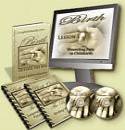Best Labor and Birth Positions
The choice of labor and birth positions plays a critical role in the mother's comfort level during birth and how quickly and effectively her labour does - or does not - progress. Effective positioning can speed labor and reduce discomfort by aligning the baby properly, by reducing area-specific pressure, and by reducing unnecessary muscular effort. In one study, mothers who changed positions frequently during labor and birth demonstrated a 50% reduction in time progressing from 3cm to 10cm dilatation.(1)
Research also demonstrates that birthing in a non-supine position can lead to lower levels of reported back pain, reduced pain during pushing, fewer perineal tears which also serves to reduce the need for suturing or surgical repair of the pelvic floor and overall easier pushing.(2) When unrestricted birth positions are available, mothers are better able to adapt to changes throughout the first and second stages of labor.
The Curse of Convenience
While US hospital practices are beginning to come in line with research evidence regarding the importance of mobility during both portions of first stage early labour and active labor , with 24% of mothers reporting walking around or moving once they were admitted to the hospital and regular contractions had begun,(3), such is not the case for second stage labor.(3, 4)
For the majority of US women giving birth in hospitals, the most-used birth positions for second stage labor, the birth of the baby, remain lithotomy (flat-on-back with legs pulled back to either side) and semi-sitting, also known as the C-position (resting on tailbone with body curled in the shape of a C) which are used in 65.9% of vaginal births.(4, 5, 6)
"More than half (57%) of women who gave birth vaginally reported that they lay on their backs while pushing their baby out and giving birth. Slightly more than one-third (35%) indicated they gave birth in a propped up (semi-sitting) position, while the remainder gave birth either on their side (4%), upright (e.g. squatting or sitting) (3%) or in a hands-and-knees position (1%). "Listening to Mothers II: Report of the Second National U.S. Survey of Women's Childbearing Experiences.(3)
Unfortunately, the use of these birth positions is rooted in convenience for doctors, not research evidence.(7) While they allow doctors easiest access to the birthing woman, they are detrimental for many reasons. Foremost is that the pelvic outlet is up to 30% smaller; it forces the woman to put direct pressure on her sacrum (tailbone) which flexes it upward, forcing it into a curved position which restricts the diameter of the pelvic outlet and can inhibit the baby's descent through the maternal pelvis. The birth canal is effectively placed in an "uphill" orientation, forcing the mother to push upward against gravity to expel the baby.
When a woman's legs are held back, a woman is also at risk of developing or worsening symphysis pubic dysfunction if excessive, unequal force is applied to either leg. The pubic symphysis is the location where the two sides of the pelvis meet at the groin.
While in lithotomy, if too much pressure is exerted on the woman's legs, excessive hip abduction and external rotation occur which can further distract the joint, forcing the sides of the pelvis apart, resulting in excruciating postpartum pain as well as prolonged supra-pubic pain for the mother and lasting complications after birth such as difficulty walking severe enough to require the use of crutches or a wheelchair, or more rarely, bladder dysfunction.(8) Dorsal lithotomy also restricts a woman from freely moving and puts greater pressure on the perineum, all of which can lead to other unnecessary interventions or complications like tearing, episiotomy, forceps delivery, or vacuum extraction.(9, 10, 11)
Mothers who elect epidurals are at higher risk for developing symphysis pubic dysfunction. If the dosage of drugs is too high, she can lose all sensation below the waist, which may leave her unable to sense when too much force is being applied or whether she is pushing with excessive effort. Her mobility is also greatly restricted which in turn further restricts her choice of birth positions, especially during second stage labor, the pushing stage.
In addition, risk to the baby also increases. Ineffective birth positions like lithotomy can compress major blood vessels which interferes with circulation and lowers maternal blood pressure, which can then lower fetal transcutaneous oxygen saturation as much as 91% (12) decrease fetal heart rate or contribute to other forms of fetal distress, including cord compression, which may lead to continuous or internal fetal monitoring, increased risk of shoulder dystocia/problems with fetal presentation, or a prolonged pushing phase.(13, 14, 15)
"An ideal birth position allows the mother's sacrum and coccyx the freedom to rotate backward, the rest of the pelvis room to open to optimal dimensions to allow for birth, and contractions to remain strong and close together. She (the mother) should choose the position that best enhances the quality of her contractions and her ability to push."Anne Frye in Holistic Midwifery: A Comprehensive Textbook for Midwives in Homebirth Practice, Vol. 2: Care of the Mother and Baby from the Onset of Labor Through the First Hours After Birth
Optimal Labor and Birth Positions
There are five main types of labor and birth positions. It's important to note that most of these positions can be used for both early labour and second stage active labor. While some are definitely not glamorous, they offer unique benefits to labor and birth. These include:
Hands-and-Knees Positions
Quadruped childbirth positions, which include the "crawl" and the "full moon", are beneficial for back labor, turning a posterior baby, and are often the best birth positions for birthing a large baby.
Sitting Positions
Sitting positions combine the helpful force of gravity with relaxation. A birth ball, rocking, or toilet sitting can be utilized to rest while gravity helps labor progress.
Squatting Positions
Squatting positions are helpful in opening the pelvis to allow a baby to find the optimal position for birth. Squatting can be performed through use of a birth companion or a tool such as a squatting bar.
Side-Lying Positions
Lateral or Side-lying positions are beneficial for resting during a long labour, promoting body-wide relaxation, and minimizing extra muscular effort. They are best used in the latter stages of labor since gravity isn't able to speed the process.
Upright or Standing Positions
Upright positions for childbirth use gravity to the mother's advantage. They help the baby drop into the pelvis and prevent pressure from being concentrated in a particular spot. They also allow the birth companions to apply other comfort measures easily. They represent the most under-used birth positions.
References
1. Mendez-Bauer C, & Newton M. 1986. Maternal position in labor. In Philip A, Barnes J, & Newton M (Eds.). Scientific foundations of obstetrics and gynaecology. London: Heinemann2. Gardosi, J., Sylvester, S. and B-Lynch, C. (1989), Alternative positions in the second stage of labour: a randomized controlled trial. BJOG: An International Journal of Obstetrics & Gynaecology, 96: 1290-1296.
3. Declercq ER, Sakala C, Corry MP, Applebaum S. Listening to Mothers II: Report of the Second National U.S. Survey of Women's Childbearing Experiences. New York: Childbirth Connection, October 2006. Available at: www.childbirthconnection.org/listeningtomothers/
4. Shorten, A., Donsante, J. and Shorten, B. (2002), Birth Position, Accoucheur, and Perineal Outcomes: Informing Women About Choices for Vaginal Birth. Birth, 29: 18-27.
5. Gupta JK, Hofmeyr GJ, Smyth R. Position in the second stage of labour for women without epidural anaesthesia. Cochrane Database of Systematic Reviews 2004, Issue 1. Art. No.: CD002006. DOI: 10.1002/14651858.CD002006.pub2.
6. Lawrence A, Lewis L, Hofmeyr GJ, Dowswell T, Styles C. Maternal positions and mobility during first stage labour. Cochrane Database of Systematic Reviews 2009, Issue 2. Art. No.: CD003934. DOI: 10.1002/14651858.CD003934.pub2
7. Harry Oxorn, MD Human Labor and Birth (University of Ottawa, Ontario, Canada,McGraw-Hill Professional Publishing)1986
8. Snow, R., Neubert, A. Peripartum Pubic Symphysis Separation: A Case Series and Review of the Literature. Obstetrical & Gynecological Survey: July 1997 - Volume 52 - Issue 7 - pp 438-443
9. Roberts CL, Algert CS, Cameron CA, & Torvaldsen S. 2005. A meta-analysis of upright positions in the second stage to reduce instrumental deliveries in women with epidural analgesia. Acta obstetricia et gynecologica Scandinavica. 84(8):794-8. Back.
10. De Jonge A, Teunissen TA, & Lagro-Janssen AL. 2004. 2004. Supine position compared to other positions during the second stage of labor: a meta-analytic review. Journal of Psychosomatic Obstetrics & Gynecology. 25(1):35-45.Back.
11. Nasir A, Korejo R, Noorani KJ. 2007. Child birth in squatting position. Journal of the Pakistan Medical Association. 57(1):19-22.
12. Humphrey et al "The influence of maternal posture at birth on the fetus" J Obstet Gynecol Br Commonwealth 80:1075, 1973
13. Athukorala C, Middleton P, Crowther CA. Intrapartum interventions for preventing shoulder dystocia. Cochrane Database of Systematic Reviews 2006, Issue 4. Art. No.: CD005543. DOI: 10.1002/14651858.CD005543.pub2.
14. Hofmeyr GJ, Gyte G. Interventions to help external cephalic version for breech presentation at term. Cochrane Database of Systematic Reviews 2004, Issue 1. Art. No.: CD000184. DOI: 10.1002/14651858.CD000184.pub2.
15. Clark SL, Cotton DB, Pivarnik JM, et al. 1991. Position change and central hemodynamic profile during normal third-trimester pregnancy and post-partum. American Journal of Obstetrics and Gynecology. 164: 883-7
Return from Birth Positions to Giving Birth Naturally Home
Page Last Modified by Catherine Beier, MS, CBE
Most Popular
How to Use Acupressure to Induce Labor
Childbirth Relaxation Script MP3s
Nutrition During Pregnancy - Nix the Notion of Eating for Two
Looking for a Birth Professional? Search our Provider Directory
Online Childbirth Classes
Choose 7 week, 12 week, or Self- Paced online childbirth classes available wherever and whenever you need them.
Featured Birth Story
Vanessa's natural birth story shows that when birth is left alone to proceed as it should, it waits for no one - not even doctors or midwives.
Free Pregnancy Tickers
Create a free pregnancy ticker to post on your blog, website, Facebook profile or favorite social media...




